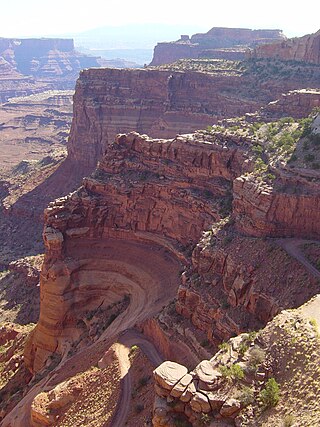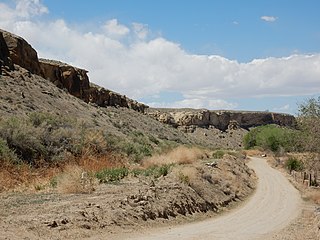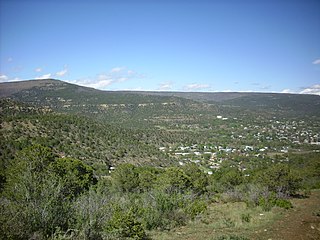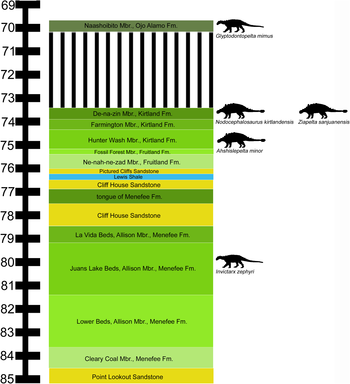The exposed geology of the Bryce Canyon area in Utah shows a record of deposition that covers the last part of the Cretaceous Period and the first half of the Cenozoic era in that part of North America. The ancient depositional environment of the region around what is now Bryce Canyon National Park varied from the warm shallow sea in which the Dakota Sandstone and the Tropic Shale were deposited to the cool streams and lakes that contributed sediment to the colorful Claron Formation that dominates the park's amphitheaters.

The Colorado Plateau, also known as the Colorado Plateau Province, is a physiographic and desert region of the Intermontane Plateaus, roughly centered on the Four Corners region of the southwestern United States. This province covers an area of 336,700 km2 (130,000 mi2) within western Colorado, northwestern New Mexico, southern and eastern Utah, northern Arizona, and a tiny fraction in the extreme southeast of Nevada. About 90% of the area is drained by the Colorado River and its main tributaries: the Green, San Juan, and Little Colorado. Most of the remainder of the plateau is drained by the Rio Grande and its tributaries.

The exposed geology of the Canyonlands area is complex and diverse; 12 formations are exposed in Canyonlands National Park that range in age from Pennsylvanian to Cretaceous. The oldest and perhaps most interesting was created from evaporites deposited from evaporating seawater. Various fossil-rich limestones, sandstones, and shales were deposited by advancing and retreating warm shallow seas through much of the remaining Paleozoic.

The exposed geology of the Capitol Reef area presents a record of mostly Mesozoic-aged sedimentation in an area of North America in and around Capitol Reef National Park, on the Colorado Plateau in southeastern Utah.

The Moenkopi Formation is a geological formation that is spread across the U.S. states of New Mexico, northern Arizona, Nevada, southeastern California, eastern Utah and western Colorado. This unit is considered to be a group in Arizona. Part of the Colorado Plateau and Basin and Range, this red sandstone was laid down in the Lower Triassic and possibly part of the Middle Triassic, around 240 million years ago.

The San Juan Basin is a geologic structural basin located near the Four Corners region of the Southwestern United States. The basin covers 7,500 square miles and resides in northwestern New Mexico, southwestern Colorado, and parts of Utah and Arizona. Specifically, the basin occupies space in the San Juan, Rio Arriba, Sandoval, and McKinley counties in New Mexico, and La Plata and Archuleta counties in Colorado. The basin extends roughly 100 miles (160 km) N-S and 90 miles (140 km) E-W.

The Bisti/De-Na-Zin Wilderness is a 45,000-acre (18,000 ha) wilderness area located in San Juan County in the U.S. state of New Mexico. Established in 1984, the Wilderness is a desolate area of steeply eroded badlands managed by the Bureau of Land Management, except three parcels of private Navajo land within its boundaries. The John D. Dingell, Jr. Conservation, Management, and Recreation Act, signed March 12, 2019, expanded the Bisti/De-Na-Zin Wilderness by approximately 2,250 acres.
The Crevasse Canyon Formation is a coal-bearing Cretaceous geologic formation in New Mexico and Arizona.

The Pictured Cliffs Formation is a Campanian geologic formation in the San Juan Basin of New Mexico. Dinosaur remains are among the fossils that have been recovered from the formation, although none have yet been referred to a specific genus.

The Point Lookout Sandstone is a Cretaceous bedrock formation occurring in New Mexico and Colorado.

The Menefee Formation is a lower Campanian geologic formation found in Colorado and New Mexico, United States.

The Mancos Shale or Mancos Group is a Late Cretaceous geologic formation of the Western United States.

The Lewis Shale is a geologic formation in the Western United States. It preserves fossils dating back to the Campanian to Maastrichtian stages of the late Cretaceous period.
The Atarque Sandstone is a geologic formation in New Mexico. It preserves fossils dating back to the late Cretaceous period.

The Gallup Sandstone is a geologic formation in the Gallup-Zuni basin of New Mexico. It preserves fossils dating back to the late Cretaceous period.

The geology of Utah, in the western United States, includes rocks formed at the edge of the proto-North American continent during the Precambrian. A shallow marine sedimentary environment covered the region for much of the Paleozoic and Mesozoic, followed by dryland conditions, volcanism, and the formation of the basin and range terrain in the Cenozoic.

The Trinidad Sandstone is a geologic formation in northeastern New Mexico and southeastern Colorado. It was formed during the Campanian Age of the Cretaceous Period and contains fossils.

Point Lookout is an 8,427-foot elevation sandstone summit located in Mesa Verde National Park, in Montezuma County of southwest Colorado. This prominent landmark is situated 2 miles (3.2 km) south of the park entrance, and 9.3 miles (15.0 km) east-southeast of the town of Cortez, and towers 1,600 feet above the surrounding terrain of Mancos Valley. Soldiers from Fort Lewis army post used its lofty position to send heliographic signals to troops campaigning in the west. A trail climbs 2.2 miles round-trip to the top and offers views of Montezuma and Mancos valleys, as well as the La Plata Mountains. This geographical feature's name was officially adopted in 1934 by the U.S. Board on Geographic Names.

Chimney Rock is an 6,110-foot (1,860 meter) elevation pillar located within the Ute Mountain Tribal Park, in Montezuma County of southwest Colorado. This landmark is situated one mile southeast of the junction of U.S. Route 491 and US 160, and towers 900 feet above the floor of the Mancos River Valley. This geographical feature is also known as Jackson Butte, named for William Henry Jackson (1843–1942), photographer and explorer famous for his images of the American West who visited this area during the Hayden Survey. He was the first to photograph the cliff dwellings in this Mesa Verde region of the Four Corners area.

















